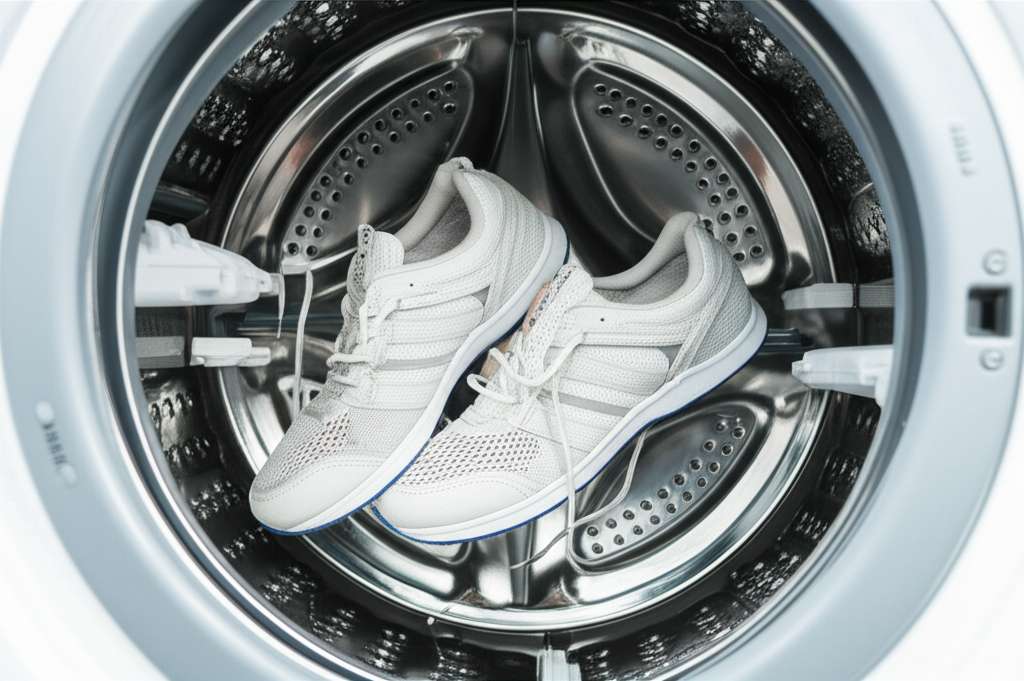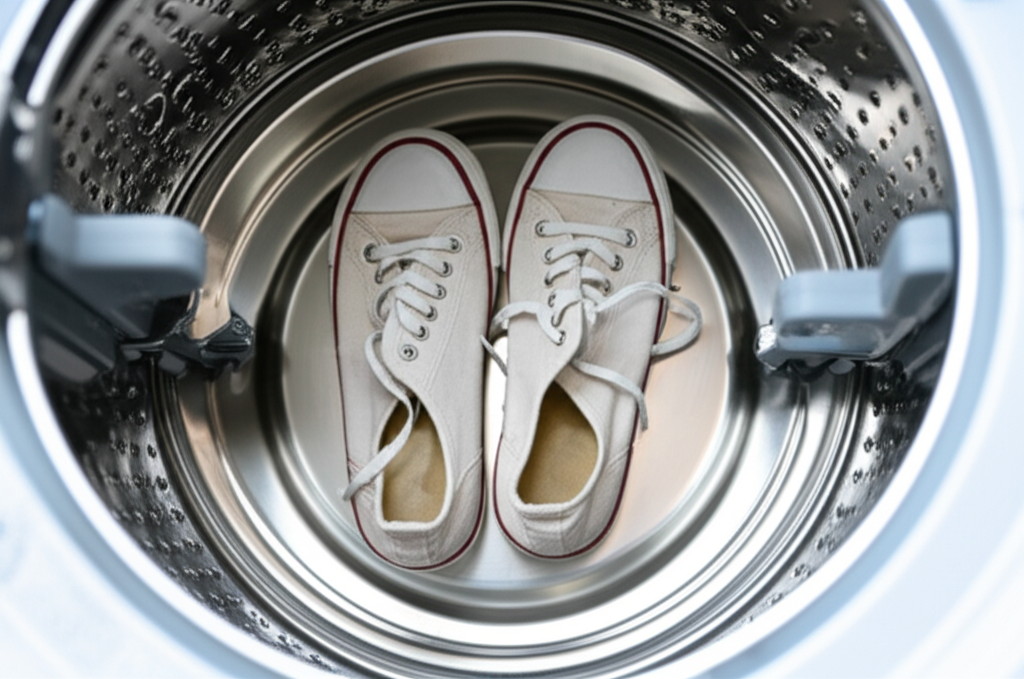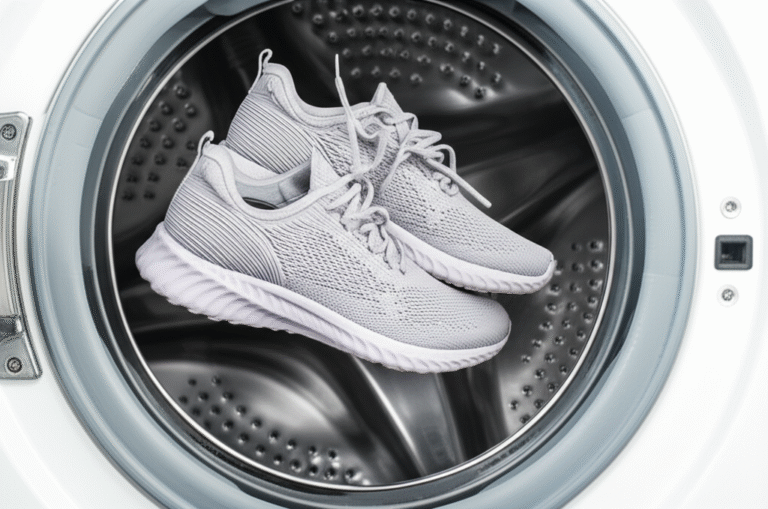Yes, you can clean most shoes in a washing machine! This effortless guide shows you exactly how to wash shoes safely and effectively, removing dirt and odors to make them look like new again.
Key Takeaways
- Prepare shoes by removing laces and insoles.
- Protect shoes and machine with a mesh bag and towels.
- Use cold water and a gentle detergent.
- Air dry shoes completely; avoid direct heat.
- Test delicate materials before machine washing.
How to Clean Shoes in Washing Machine: Your Effortless Guide
Are your favorite sneakers looking a little worse for wear? Do you dread the thought of scrubbing away at stubborn dirt and grime? Many people find shoe cleaning to be a chore, but what if there was a simpler way? Cleaning shoes in the washing machine can be surprisingly effective and incredibly easy. It’s a common question: can you really just toss your shoes in there? The answer is a resounding yes, for many types of footwear! This guide will walk you through the entire process, step-by-step, so you can confidently refresh your shoes and get them looking fantastic again without all the fuss. Let’s discover how to make your shoes shine with minimal effort.
Why Machine Wash Your Shoes?

Keeping your shoes clean is about more than just aesthetics. Dirty shoes can harbor bacteria and odors, which isn’t ideal. Regular cleaning also helps extend the lifespan of your footwear. Think about it: when shoes are constantly exposed to the elements, they pick up all sorts of things – mud, dust, salt, and even food spills. Over time, this buildup can degrade the materials, making them look old and worn out prematurely. Machine washing offers a quick, efficient, and thorough way to tackle this. It can reach into crevices and fabric weaves that hand scrubbing might miss, lifting away dirt and refreshing the materials. It’s a solution for busy people who want clean shoes without spending hours on them. Plus, it’s a budget-friendly alternative to professional cleaning services.
What Types of Shoes Can Be Machine Washed?
Before you throw just any pair into the wash, it’s crucial to know which materials can handle it. Not all shoes are created equal, and some delicate materials can be damaged by the agitation and heat of a washing machine. Generally, shoes made from canvas, synthetic fabrics, and most mesh materials are good candidates. This includes many athletic sneakers, casual canvas shoes, and some fabric-based slip-ons. However, shoes made from leather, suede, nubuck, or those with delicate embellishments like sequins or intricate embroidery are usually best cleaned by hand. It’s always a good idea to check the manufacturer’s care label if you’re unsure. If there’s no label, err on the side of caution and opt for hand washing for these materials.
Here’s a quick look at common shoe types and their washability:
| Shoe Type | Washing Machine Friendly? | Notes |
|---|---|---|
| Canvas Sneakers | Yes | Excellent candidates for machine washing. |
| Mesh Athletic Shoes | Yes | Generally safe, but check for delicate areas. |
| Synthetic Fabric Shoes | Yes | Good to go, similar to canvas. |
| Leather Shoes | No | Requires specialized leather cleaners and hand care. |
| Suede/Nubuck Shoes | No | Very sensitive to water; requires specific suede brushes and cleaners. |
| Shoes with Electronics (e.g., light-up soles) | No | Water can damage internal components. |
| Shoes with Delicate Embellishments | No | Beads, sequins, embroidery can be damaged or snagged. |
| Woolen Shoes | Sometimes | Check label; use a wool cycle and cold water if allowed. |
Gather Your Supplies

Before you start, make sure you have everything you need. Having your supplies ready will make the process smooth and efficient. You don’t want to be halfway through and realize you’re missing a crucial item.
- Washing Machine: Ensure it’s clean and in good working order.
- Mesh Laundry Bags or Pillowcase: This is crucial for protecting your shoes and your machine. It prevents laces from tangling and shoes from banging against the drum.
- Old Towels: To balance the load and further protect the shoes and machine.
- Mild Laundry Detergent: Avoid harsh chemicals or bleach, which can damage colors and materials. A gentle, liquid detergent is best.
- Shoe Brush (Optional): For pre-treating stubborn stains.
- Old Toothbrush (Optional): For scrubbing soles and details.
- Removable Insoles and Laces: To be cleaned separately.
Step-by-Step Guide to Machine Washing Your Shoes
Now that you have your supplies, let’s get those shoes sparkling! Follow these steps carefully for the best results.
Step 1: Preparation is Key
This is perhaps the most important step. Proper preparation ensures your shoes are cleaned effectively and prevents damage.
- Remove Loose Dirt: Take your shoes outside and bang the soles together to dislodge any large chunks of mud or dirt. You can also use a dry brush or an old toothbrush to brush away surface debris.
- Remove Laces and Insoles: Pull out the shoelaces and the insoles. These often trap dirt and odors and can be cleaned more effectively separately.
- Pre-treat Stains: For any particularly stubborn stains on the fabric or rubber soles, apply a small amount of liquid laundry detergent or a specialized shoe cleaner directly to the stain. Gently scrub with an old toothbrush or a soft brush. Let it sit for about 10-15 minutes before proceeding.
Step 2: Load the Washing Machine Correctly
How you load the machine is critical for preventing damage to both your shoes and the appliance.
- Use a Mesh Bag: Place each shoe (or a pair, depending on the bag size) into a separate mesh laundry bag. If you don’t have mesh bags, a clean pillowcase secured with a knot can work. This prevents the shoes from getting scuffed or damaged by direct contact with the drum and stops laces from tangling.
- Add Towels: Throw in a couple of old, color-fast towels with the shoes. These act as buffers, absorbing some of the impact and balancing the load. Without them, the machine can become unbalanced, leading to excessive noise and potential damage.
- Don’t Overload: Avoid washing too many pairs of shoes at once. One or two pairs are usually sufficient for a standard wash cycle.
Step 3: Select the Right Wash Cycle and Settings
Choosing the correct settings will ensure a thorough clean without being too harsh.
- Water Temperature: Always use COLD water. Hot water can warp shoe materials, fade colors, and damage adhesives. Cold water is effective for removing dirt and stains without causing harm.
- Wash Cycle: Select a gentle or delicate cycle. These cycles use less agitation and a slower spin speed, which is ideal for protecting the integrity of your shoes.
- Detergent Amount: Use only a small amount of mild, liquid laundry detergent. Too much detergent can leave residue on the shoes, and powder detergents might not dissolve completely. Avoid fabric softeners, as they can degrade shoe materials.
- No Bleach: Never use bleach, as it will likely discolor and damage your shoes.
Step 4: Washing the Laces and Insoles
While the shoes are in the wash, tackle the laces and insoles.
- Laces: Place the removed shoelaces in a small mesh bag or a tied-off pillowcase. Wash them with the rest of your laundry on a regular cycle with your usual detergent. This will get them thoroughly clean.
- Insoles: Insoles can be tricky. If they are made of fabric and foam, you can often hand wash them with warm water and a bit of detergent, scrubbing gently with a brush. Rinse them thoroughly and allow them to air dry completely. Some very basic insoles might be machine washable, but it’s a riskier move. For best results and to avoid damage, hand washing is recommended. Check the manufacturer’s guidelines if available.
Step 5: Drying Your Shoes
This is another crucial step where damage can occur if done incorrectly. NEVER put your shoes in a machine dryer.
- Remove Immediately: As soon as the wash cycle is finished, remove the shoes and laces from the machine.
- Air Dry Only: The best way to dry shoes is to let them air dry. Stuff them loosely with plain white paper towels or newspaper (avoid colored ink as it can transfer). This helps absorb excess moisture from the inside and helps them maintain their shape.
- Avoid Direct Heat: Do NOT place shoes near direct heat sources like radiators, fireplaces, or in direct sunlight for extended periods. Heat can warp plastics, shrink materials, and damage adhesives, leading to the shoes falling apart.
- Patience is Key: Allow shoes to dry completely, which can take 24-48 hours or even longer, depending on the material and humidity. Ensure they are fully dry before wearing them again to prevent odor and potential fungal growth.
Cleaning Different Shoe Materials Safely
While the washing machine is great for many shoes, some materials require a gentler approach. Here’s how to handle them:
Canvas Shoes
Canvas is very forgiving. Follow the machine washing steps above. For stubborn scuffs on the rubber parts, a magic eraser or a baking soda paste can work wonders after washing.
Mesh Sneakers
Mesh is also generally machine washable. Be extra careful with the mesh itself, as it can be delicate. Always use a mesh bag and a gentle cycle with cold water. Inspect any plastic or rubber overlays for damage before washing.
Leather Shoes
Leather requires a completely different cleaning regimen. Machine washing will dry out, crack, and ruin leather. To clean leather shoes:
- Wipe off loose dirt with a dry cloth.
- Use a damp cloth with a bit of mild soap (like saddle soap or a specialized leather cleaner) to wipe down the surface.
- For deeper cleaning, use a leather cleaner according to product instructions.
- After cleaning and drying, always apply a leather conditioner to keep the material supple and prevent cracking.
- Visit The Leather Council of America for more in-depth leather care tips.
Suede and Nubuck Shoes
Suede and nubuck are highly sensitive to water and stains. Machine washing will likely ruin them. To clean suede or nubuck:
- Use a specialized suede brush to remove dry dirt and revive the nap.
- For stains, use a suede eraser or a suede cleaning kit.
- Avoid water as much as possible. If absolutely necessary, use a suede protector spray after cleaning and drying.
- For tough stains, consider professional cleaning services.
Synthetic and Athletic Shoes
Most synthetic and modern athletic shoes are designed to be durable and are usually safe for machine washing. The key is the gentle cycle, cold water, and air drying. These shoes often feature breathable materials and advanced cushioning systems that can be refreshed effectively this way.
Dealing with Odors
Even after washing, stubborn odors can sometimes linger. Here are a few extra tips:
- Baking Soda: Sprinkle baking soda inside your shoes and let them sit overnight. Then, vacuum or brush it out. Baking soda is a natural deodorizer. You can also add about half a cup of baking soda to the wash cycle along with your detergent.
- White Vinegar: A cup of white vinegar added to the rinse cycle can help neutralize odors and disinfect. Don’t worry, the vinegar smell will dissipate as the shoes dry.
- Drying Thoroughly: Ensuring shoes are completely dry is crucial. Damp environments encourage bacterial growth, which causes odor.
- Sunlight: Once dry, leaving shoes in direct sunlight for a few hours can also help kill odor-causing bacteria naturally.
Pro Tips for Shoe Washing Success
Want to take your shoe cleaning game to the next level? Here are some expert insights:
- Pre-treat Soles: The rubber or foam soles often get the dirtiest. Use an old toothbrush and a paste of baking soda and water to scrub these areas before washing.
- Clean Your Machine: Regularly clean your washing machine drum to prevent dirt and residue from transferring to your shoes. Run an empty hot cycle with vinegar or a washing machine cleaner.
- Don’t Over-Wash: While machine washing is convenient, avoid doing it too frequently, especially for shoes with more delicate components. Hand washing or spot cleaning might be sufficient for minor dirt.
- Check Manufacturer’s Care Instructions: If you can find them, always refer to the brand’s specific cleaning advice. Some brands have unique materials or construction that require special care. For example, some athletic shoe manufacturers provide detailed care guides on their websites.
- Consider Shoe Trees: After washing and drying, cedar shoe trees can help absorb any residual moisture and maintain the shoe’s shape.
Frequently Asked Questions (FAQ)
Can I wash all my shoes in the washing machine?
No, not all shoes are suitable for machine washing. Leather, suede, nubuck, and shoes with delicate embellishments or electronic components should not be machine washed. Stick to canvas, mesh, and synthetic fabric shoes.
Will machine washing ruin my shoes?
If done incorrectly, yes. However, by following the steps for preparation, using a mesh bag, cold water, a gentle cycle, and air drying, you can significantly minimize the risk of damage.
How often should I wash my shoes in the machine?
It depends on how often you wear them and how dirty they get. For most everyday shoes, washing them once every few months or when they show visible dirt is usually sufficient. Over-washing can still wear down materials over time.
Can I use bleach to whiten my shoes?
It’s generally not recommended. Bleach can be too harsh, causing discoloration, weakening fabric, and damaging adhesives. For whitening, consider using specialized shoe cleaners or a paste of baking soda and hydrogen peroxide (use with caution and test on an inconspicuous area first).
What is the best way to dry shoes after washing?
Always air dry your shoes. Stuff them with paper towels or newspaper to absorb moisture and maintain shape. Avoid direct heat sources like dryers, radiators, or direct sunlight, as heat can cause irreparable damage.
My shoes still smell after washing, what can I do?
Ensure they are completely dry. You can also try the baking soda trick (sprinkle inside, let sit, then vacuum/brush out) or add white vinegar to the rinse cycle next time. Keeping them dry and well-ventilated is key to preventing future odors.
Can I wash my running shoes or gym shoes in the washing machine?
Yes, most modern running and gym shoes made of synthetic materials, mesh, and fabric are designed to withstand machine washing. Just follow the gentle cycle, cold water, and air dry instructions to keep them in good condition.
Conclusion
Cleaning your shoes in the washing machine doesn’t have to be a daunting task. By taking a few simple precautions – like preparing your shoes, using a mesh bag, opting for cold water and a gentle cycle, and most importantly, air drying – you can effectively refresh most of your footwear. This method is a fantastic way to save time and money while keeping your favorite sneakers and casual shoes looking their best. Remember to always check your shoe’s material and manufacturer’s guidelines if you’re unsure. With this effortless guide, you’re well-equipped to tackle shoe cleaning with confidence and achieve great results every time.

